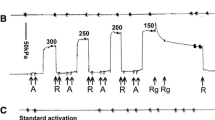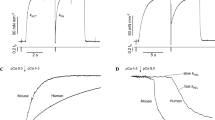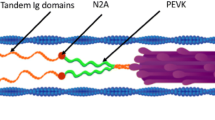Abstract
Recent atomic 3-D reconstructions of the acto-myosin interface suggest that electrostatic interactions are important in the initial phase of cross-bridge formation. Earlier biochemical studies had also given strong evidence for the ionic strength dependence of this step in the cross-bridge cycle. We have probed these interactions by altering the ionic strength (Γ/2) of the medium mainly with K+, imidazole+ and EGTA2– to vary charge shielding. We examined the effect of ionic strength on the kinetics of rigor development at low Ca2+ (experimental temperature 18–22°C) in chemically skinned single fast-twitch fibres of mouse extensor digitorum longus (EDL) muscle. On average the delay before rigor onset was 10 times longer, the maximum rate of rigor tension development was 10 times slower, the steady-state rigor tension was 3 times lower and the in-phase stiffness was 2 times lower at high (230 mM) compared to low (60 mM) ionic strength. These results were modelled by calculating ATP depletion in the fibre due to diffusional loss of ATP and acto-myosin Mg.ATPase activity. The difference in delay before rigor onset at low and high ionic strength could be explained in our model by assuming a 15 times higher Mg.ATPase activity and a threefold increase in K m in relaxing conditions at low ionic strength. Activation by Ca2+ induced at different time points before and during onset of rigor confirmed the calculated time course of ATP depletion. We have also investigated ionic strength effects on rigor development with the activated troponin/tropomyosin complex. ATP withdrawl at maximum activation by Ca2+ induced force transients which led into a ”high rigor” state. The peak forces of these force transients were very similar at low and high ionic strength. The subsequent decrease in tension was only 10% slower and steady-state ”high rigor” tension was reduced by only 27% at high compared to low ionic strength. Addition of 10 mM phosphate to lower cross-bridge attachment strongly suppressed the transient increases in force at high ionic strength and reduced the steady-state rigor tension by 17%. A qualitatively similar but smaller effect of phosphate was observed at low ionic strength where steady-state rigor force was reduced by 10%. The data presented in this study show a very strong effect of ionic strength on rigor development in relaxed fibres whereas the ionic strength dependence of rigor development after thin filament activation was much less. The data confirm the importance of electrostatic interactions in cross-bridge attachment and cross-bridge-attachment-induced activation of thin filaments.
Similar content being viewed by others
Author information
Authors and Affiliations
Additional information
Received: 3 September 1997 / Received after revision and accepted: 12 December 1997
Rights and permissions
About this article
Cite this article
Veigel, C., von Maydell, R., Kress, K. et al. The effect of ionic strength on the kinetics of rigor development in skinned fast-twitch skeletal muscle fibres. Pflügers Arch 435, 753–761 (1998). https://doi.org/10.1007/s004240050580
Issue Date:
DOI: https://doi.org/10.1007/s004240050580




